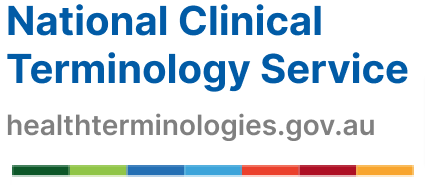SNOMED CT-AU FAQs
For further information on SNOMED CT-AU, please see What is SNOMED CT and the AMT?
How can SNOMED CT-AU be used?
The SNOMED CT-AU package is used by clinical software applications. It is a standard for the recording and exchange of clinical information. This ensures continuity of care for patients across different times, settings, and providers. Other uses include:
- clinical decision support
- statistical reporting
- outcomes measurement
- public health surveillance
- health research
- cost analysis
How often are SNOMED CT-AU updates released?
SNOMED CT-AU is updated every month. It includes the AMT and new content such as FHIR terminology resources. We encourage feedback from stakeholders, please see Contact and support.
Can I propose any enhancements to SNOMED CT or SNOMED CT-AU?
Yes! We invite you to submit requests to the NCTS. Our team can add new content, and change or remove content if it is incorrect. Please visit our Request content page for more information.
How can I import and store SNOMED CT-AU in an application?
There are many ways to extract and import SNOMED CT-AU data:
- Import all the relevant SNOMED CT-AU data into structures within the host system that are similar to the SNOMED CT RF2 distribution format.
- Export and ‘flatten’ the required data into simple list type forms and import them into the required host data structures.
- Use Ontoserver to integrate with the terminology services provided by the NCTS.
Learn more about technical approaches to implementing SNOMED CT.
How do I maintain terms in my application when a new version of SNOMED CT-AU is released?
Each system will be different. Implementers must develop processes to ensure the current version of SNOMED CT-AU is in use. This may include review of local maps and terms. Concepts in SNOMED CT may be retired but will never be deleted. SNOMED CT contains a history mechanism that allows backwards compatibility between SNOMED CT-AU versions. This is a common task when working with native SNOMED CT RF2 distribution files.
Do existing local code sets (i.e. non-SNOMED-CT) need to be mapped to implemented reference sets?
Maps are used to migrate legacy data to SNOMED CT. They can also help with the transfer of information, for example in HL7 messages and CDA documents loaded into My Health Record. Please see the Mapping considerations page for further guidance.
How do I map terms from existing systems that use different coding schemes and ensure clinical safety?
There are many issues to consider when mapping existing codes to SNOMED CT. The outcome should be a reproducible map for the purpose intended. So it is vital to understand how the data will be used before starting any mapping activity. This will ensure consistency in the mapping process. Please see the Mapping considerations page for further guidance.
Is SNOMED CT in Australia the same as in other SNOMED International member countries?
In every SNOMED International Member country, SNOMED CT contains the same core files. In addition, each Member country publishes extension material for use in local implementations. This includes
- language reference sets
- content reference sets
- drug extensions
- cross maps
- other documents.
Do I need a SNOMED CT Namespace Identifier?
The Namespace Identifier allows you to extend SNOMED CT. This includes the creation of local codes, terms and reference sets. All custom content must follow applicable standards and licensing conditions. As an affiliate Licence holder of SNOMED CT, you have the right to apply for a Namespace Identifier through SNOMED International.
First you need to check if your organisation already has a namespace for use in Australia. Search for your organisation on the SNOMED CT Namespace Identifier Registry.
To request a new SNOMED CT Namespace Identifier, contact us for a copy of the application form and policy.
What is Logical Observation Identifiers Names and Codes (LOINC)?
LOINC® is a common language (set of identifiers, codes and names) for clinical and laboratory observations. If you think of an observation as a ‘question’ and the observation result value as an ‘answer’, LOINC codes represent the ‘question’ for a test or measurement. SNOMED CT is used in conjunction with this standard to represent the ‘answer’ to the question. Visit the LOINC website for more information.
The Regenstrief Institute Inc. and SNOMED International have signed a long-term agreement to begin cooperative work linking their leading global health care terminologies LOINC, and SNOMED CT. This timely and significant agreement will help improve safety, functionality and interoperability for the rapidly growing number of clinicians who manage and exchange health data with electronic medical records.
For more information please visit the SNOMED International website.
